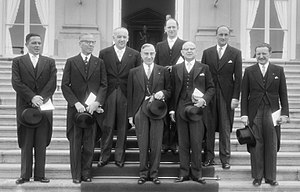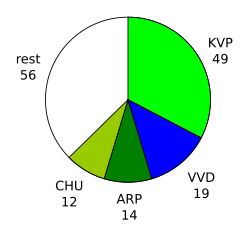De Quay cabinet | |
|---|---|
48th Cabinet of the Netherlands | |
  The installation of the De Quay cabinet on 19 May 1959 | |
| Date formed | 16 May 1959 |
| Date dissolved | 24 July 1963 4 years, 69 days in office (Demissionary from 15 May 1963) |
| People and organisations | |
| Monarch | Queen Juliana |
| Prime Minister | Jan de Quay |
| Deputy Prime Minister | Henk Korthals |
| No. of ministers | 14 |
| Ministers removed | 2 |
| Total no. of members | 16 |
| Member party | Catholic People's Party (KVP) People's Party for Freedom and Democracy (VVD) Anti-Revolutionary Party (ARP) Christian Historical Union (CHU) |
| Status in legislature | Centre-right Majority government |
| History | |
| Election | 1959 election |
| Outgoing election | 1963 election |
| Legislature terms | 1959–1963 |
| Incoming formation | 1959 formation |
| Outgoing formation | 1963 formation |
| Predecessor | Second Beel cabinet |
| Successor | Marijnen cabinet |
| Part of the Politics series |
![Azure, billetty Or a lion with a coronet Or armed and langued Gules holding in his dexter paw a sword Argent hilted Or and in the sinister paw seven arrows Argent pointed and bound together Or. [The seven arrows stand for the seven provinces of the Union of Utrecht.] The shield is crowned with the (Dutch) royal crown and supported by two lions Or armed and langued gules. They stand on a scroll Azure with the text (Or) "Je Maintiendrai" (French for "I will maintain".)](http://upload.wikimedia.org/wikipedia/commons/thumb/8/8f/State_coat_of_arms_of_the_Netherlands.svg/150px-State_coat_of_arms_of_the_Netherlands.svg.png) |
|---|
|
|
The De Quay cabinet was the executive branch of the Dutch Government from 19 May 1959 until 24 July 1963. The cabinet was formed by the christian-democratic Catholic People's Party (KVP), Anti-Revolutionary Party (ARP) and Christian Historical Union (CHU) and the conservative-liberal People's Party for Freedom and Democracy (VVD) after the election of 1959. The cabinet was a centre-right coalition and had a substantial majority in the House of Representatives with prominent Catholic politician Jan de Quay the former Queen's Commissioner of North Brabant serving as Prime Minister. Prominent Liberal politician Henk Korthals served as Deputy Prime Minister, Minister of Transport and Water Management and was given the portfolio of Suriname and Netherlands Antilles Affairs.
The cabinet served in the early years of the tumultuous 1960s; domestically it had to deal with the beginning of the counterculture and the discovery of the Groningen gas field and it was able to implement several major social reforms to the education system and the public sector and social security, internationally the West New Guinea dispute resulted in the disbandment of the Netherlands New Guinea territory following the Battle of Arafura Sea. The cabinet suffered several major internal conflicts including multiple cabinet resignations, but completed its entire term and was succeeded by a continuation of the coalition in the Marijnen cabinet following the election of 1963.[1]
- ^ "Jan de Quay: politicus met een dubbel imago" (in Dutch). Historiek. 27 December 2014. Retrieved 21 March 2018.
